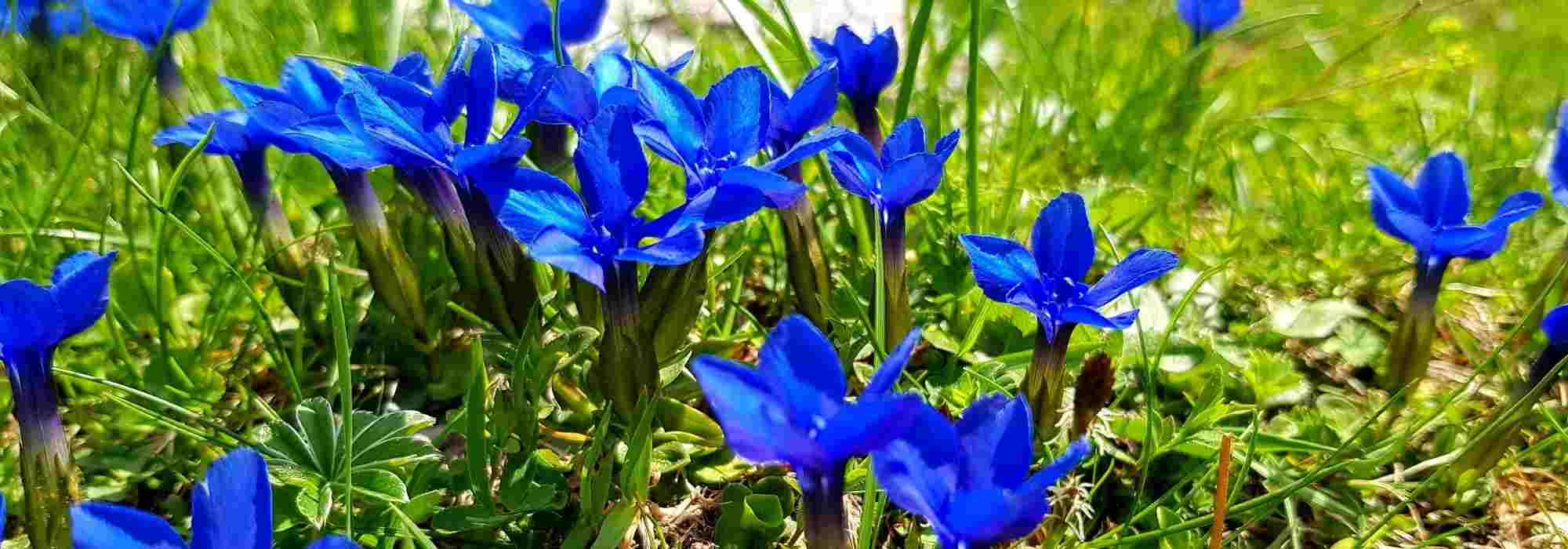
Choosing a gentian
All our tips
Contents
Plant native to the mountains, the Blue Gentian, also known as Alpine Gentian and Gentiana acaulis, is a well-known perennial for its trumpet-shaped flowers. However, this genus also comes in other colours and flower shapes. For example, there is the Yellow Gentian, which is notably used in the production of gentian liqueur and produces a completely different flowering from the Blue Gentian. Also note that not all Gentians flower at the same time of year. Their size can also vary from one species to another, as can their habit, which influences the use of these perennial plants. To help you find your ideal Gentian, check out our buying guide!
⇒ For more information, see our article Gentian: planting, growing, and care.
According to height
Creeping or upright, Gentians can vary in height depending on the species and varieties. Generally, three size categories can be distinguished:
Small Gentians under 20 cm tall
Among the smallest Gentians, very useful as groundcover plants to fill gaps at the front of borders, are the Alpine Gentian and the Spring Gentian, both forming carpets 10 cm high, spreading to about 20 cm wide. The ‘Little Pinkie’ Gentian and the Gentiana sino-ornata are slightly larger but do not exceed 20 cm in all directions at maturity. All these Gentians are suitable for pot planting to brighten up terraces and balconies.
Medium Gentians 20 to 50 cm tall
They are very numerous. Medium-sized Gentians are perfect for borders due to their upright habit. In our collection, for example, blue species and varieties such as the ‘Croisette’ Gentian, the Siberian Gentian, the Summer Gentian (Gentiana septemfida var. lagodechiana), and the ‘Blue Star’ Gentian do not exceed 30 cm in height. Their clump generally spreads to a maximum of 25 to 40 cm. As for the bright ‘White Magic’ Gentian with white flowers and the stunning Gentiana scabra ‘Royal Stripes’, they form a homogeneous silhouette of 30 cm in all directions.
Large Gentians over 50 cm tall
There are upright Gentians that can exceed 50 cm in height, such as the Asclepius Gentian and the ‘True Blue’ Gentian, both forming well-formed clumps. However, the largest remains the Yellow Gentian (Gentiana lutea), also known as the Great Gentian, reaching heights of up to 1.20 m, sometimes even 1.50 m!
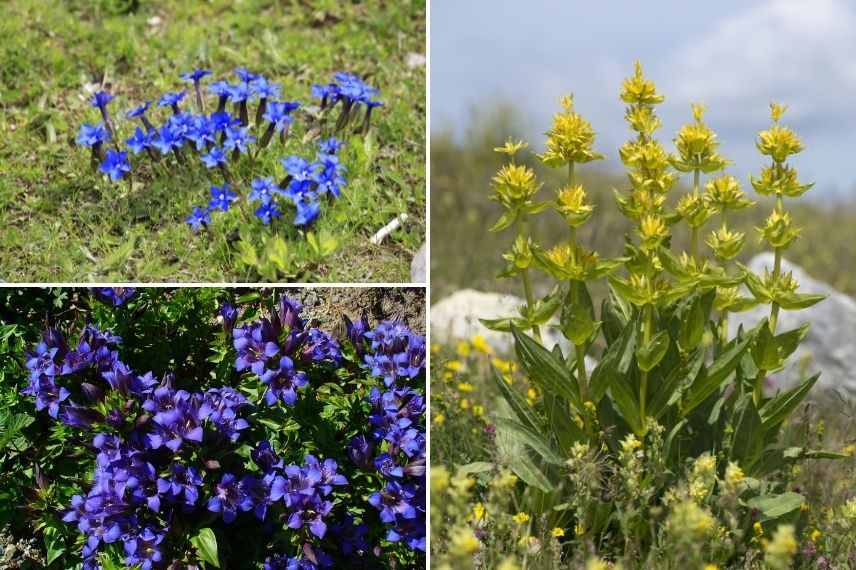
Gentiana verna, Gentiana septemfida var. lagodechiana (photo Wikipedia) and Gentiana lutea
Read also
Gentian: planting, growing and careAccording to the colour of the flower
- Very often, montane Gentians offer us a magnificent blue flowering, sometimes very intense as seen in Gentiana verna, Gentiana sino-ornata, Gentiana acaulis, Gentiana cruciata, or Gentiana septemfida var. lagodechiana. Throughout summer, Gentiana ‘True Blue’ is adorned with ultramarine blue flowers, while Gentiana ‘Blue Star’ bears blue flowers in varied shades and tones: sky blue, lavender blue, or bright blue. With a less deep blue and a light throat, the flowers of Gentiana dahurica and Gentiana asclepiadea are equally stunning.
- Some species reveal yellow flowers, such as Gentiana lutea, which produces star-shaped flowers from June to August.
- Other, lesser-known Gentians reveal white flowers. For example, Gentiana makinoi ‘White Magic’ displays slightly fragrant, white flowers washed with green and cream.
- Varieties with pink or red flowering are rather rare, but they do exist: the hybrid Gentiana ‘Little Pinkie’ takes on a beautiful magenta pink during summer.
- Finally, some astonishing specimens produce bicoloured flowers, such as Gentiana scabra ‘Royal Stripes’, blue and white.
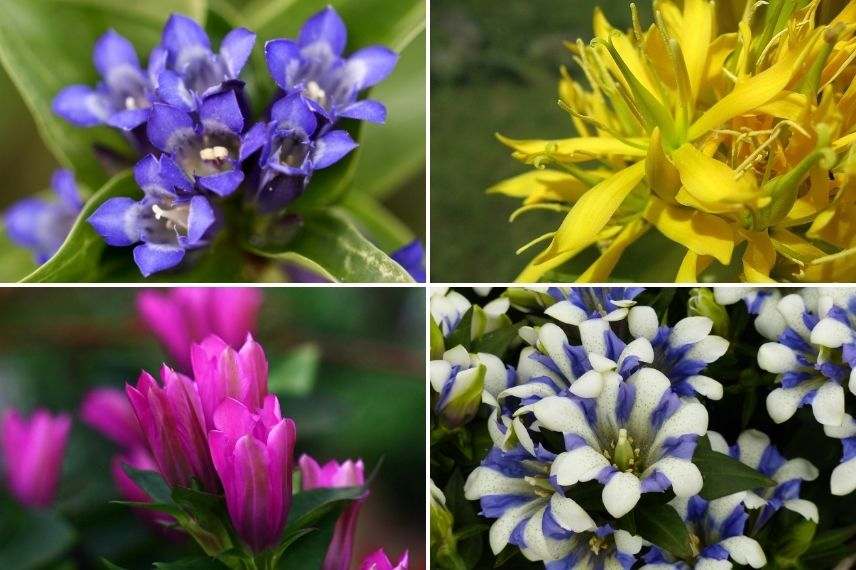
Blue flower of Gentiana cruciata, yellow flower of Gentiana lutea (photo Joan Simon), pink flower of hybrid Gentiana ‘Little Pinkie’ (photo Roy Lomas), and bicoloured flower of Gentiana scabra ‘Royal Stripes’
Discover other Gentian
View all →Available in 2 sizes
Available in 1 sizes
Available in 1 sizes
Available in 1 sizes
Available in 1 sizes
Available in 1 sizes
Available in 1 sizes
Available in 2 sizes
Available in 1 sizes
Available in 1 sizes
According to the shape of the flower
Generally, gentian flowers are presented in the form of narrow or wide trumpets, measuring 3 to 5 cm in length. The corolla has five to ten lobes that are more or less fused and plicate depending on the species and varieties. Sometimes, the throat (inside of the tube) is striate or marked with small dots.
- For example, in the Alpine Gentian and the Asclepius Gentian, the tube is wide and the pointed lobes are almost fused along their entire length.
- For the Siberian Gentian and the Summer Gentian, the lobes of the wide trumpet are rounded and more cut.
- In contrast, the Spring Gentian forms a narrow tube topped with 5 well distinct lobes arranged in a star.
In Yellow Gentian, flowering occurs on upright stems. The flowers consist of 5 to 9 fine, elongated, and unfused lobes.
Note also that the flowers can be solitary, as is the case with Gentiana sino-ornata, the stemless Gentian acaule, Gentiana verna, but also grouped in cut flower arrangements, just like Gentiana asclepiadea, Gentiana cruciata, Gentiana lutea, or Gentiana septemfida lagodechiana.
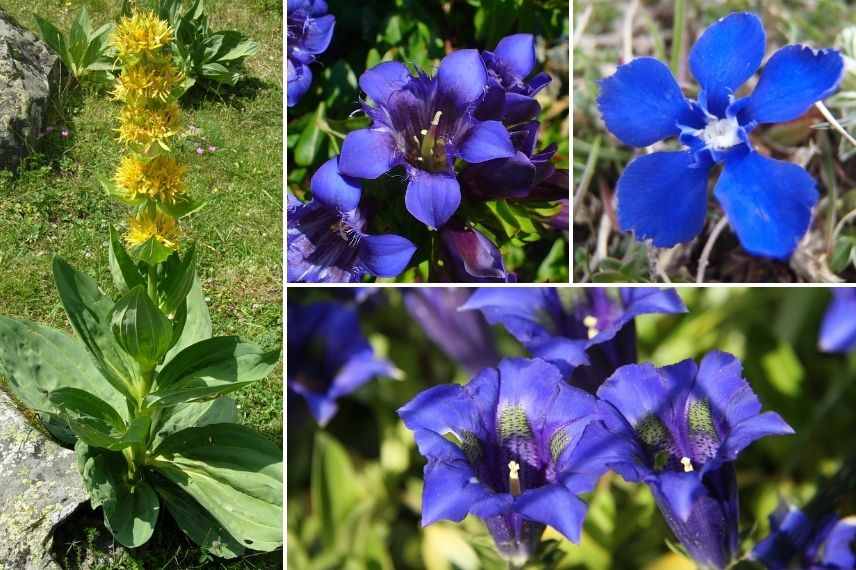
Gentiana lutea with star-shaped flowers in cut flower arrangements (photo Joan Simon), Gentiana septemfida var. lagodechiana, Gentiana verna with cut lobes (photo peupleloup), and Gentiana acaulis with fused lobes (photo maja dumat)
According to the flowering period
The choice of your Gentian may depend on the time of year it flowers.
Spring-flowering Gentians:
The earliest of them is the Gentiana verna, which begins its flowering in April and continues until June. Next, the Gentiana acaulis takes over and flowers from May to June.
Summer-flowering Gentians:
The majority of Gentians flower in summer, between June and September.
- The flowers of Gentiana cruciata, Gentiana makinoi ‘White Magic’, and the Gentian ‘Little Pinkie’ start to appear from June and bloom until August, sometimes into September. The Gentiana lutea generally only flowers for 2 months, in June and July.
- Next, the varieties ‘Blue Star’ and ‘True Blue’, as well as the Siberian Gentian, display their flowers until September.
- Soon after, the Gentiana asclepiadea and the Gentiana scabra ‘Royal Stripes’ show their flowering from August to September.
Autumn-flowering Gentians:
Finally, the Gentiana sino-ornata is the last to flower, from September to October.
According to the habit and use
Gentian is used differently depending on its habit. Indeed, spreading Gentians are best placed at the edges, along paths, on slopes, or walls. In a rockery, it is possible to install the Alpine Gentian, which is a dwarf species with a spreading habit, creating a beautiful cushion of large blue flowers. The Gentiana sino-ornata, also of low stature, is perfectly suited to these situations.
Conversely, upright Gentians are better suited for flowering borders. Medium-sized species and varieties such as the Siberian Gentian or Gentian ‘White Magic’ easily integrate into the heart of a perennial border. One can easily imagine the large Gentiana lutea in a naturalistic garden, beautifully showcasing its yellow flowering at the back of the border. Note that it has a slow growth rate, requiring 7 to 10 years before it flowers for the first time. However, its lifespan is very long: around fifty years! Be aware that it is the roots of this species that are macerated and distilled for the production of liqueurs and other spirits, imparting a characteristic bitterness to these alcoholic beverages. Additionally, this perennial plant has medicinal properties, particularly promoting good digestion and stimulating the immune system. Caution: do not confuse the Yellow Gentian (with opposite leaves) with the white veratrum (with alternate leaves), as its rhizome is toxic.
Finally, whether upright or creeping, Gentian can also be grown in pots. The unique Gentian ‘Little Pinkie’ and Gentiana scabra ‘Royal Stripes’ are stunning in flowering pots, adding a lovely splash of colour to terraces and balconies.

Flowering Gentians in a rockery, at the back of a border, or at the edge
- Subscribe!
- Contents

































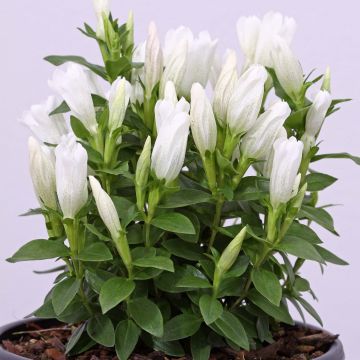

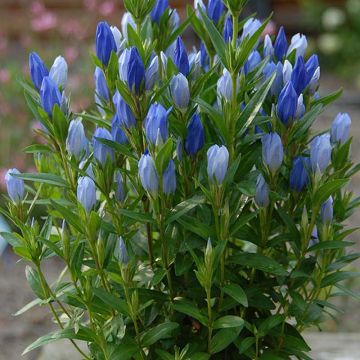
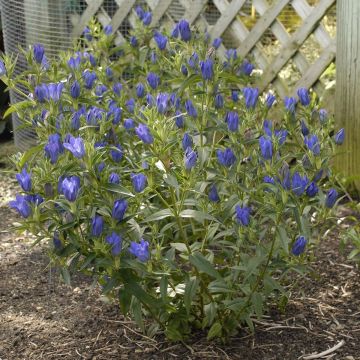

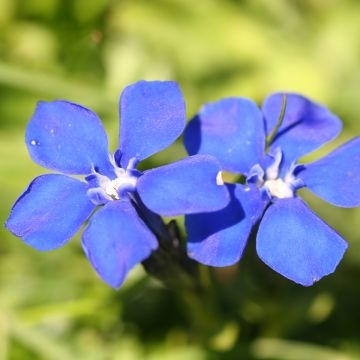



Comments